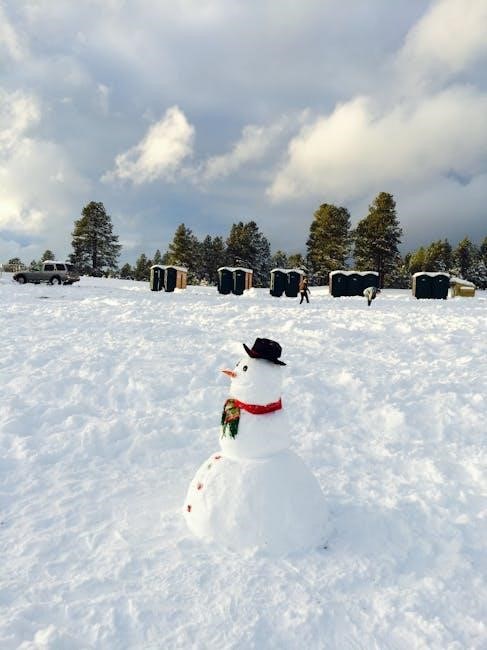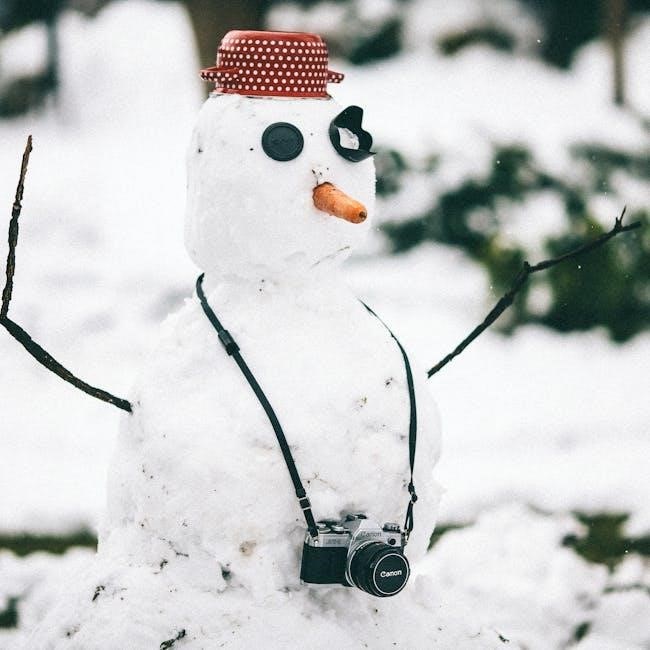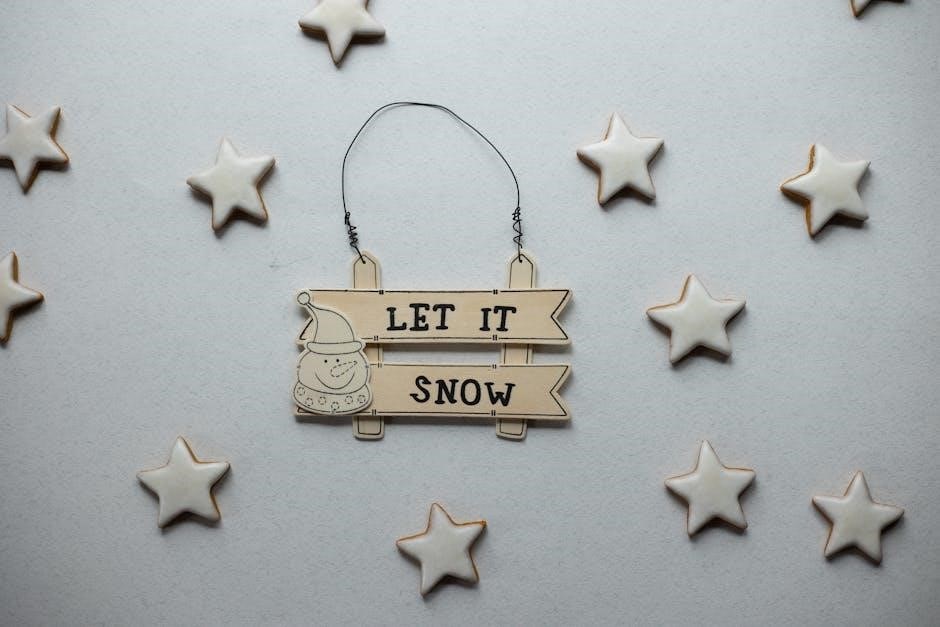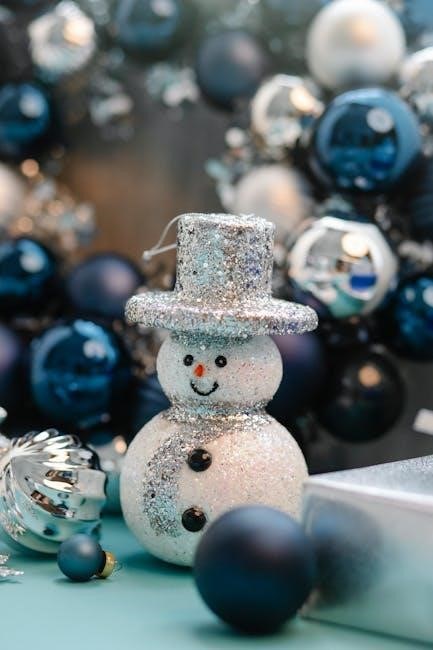
Snowman PDFs are popular resources offering a variety of snowman-related content, from storybooks to activity sheets, perfect for both educational and entertaining purposes.
1.1 Overview of Snowman PDFs
Snowman PDFs are versatile digital resources that cater to diverse interests, offering a wide range of content, from children’s storybooks to educational materials. These documents often feature colorful illustrations, engaging narratives, and interactive activities, making them ideal for both entertainment and learning. Many Snowman PDFs include craft ideas, puzzles, and quizzes, appealing to kids and adults alike. They are commonly used in educational settings to teach creativity, critical thinking, and cultural awareness. Additionally, these PDFs often highlight the cultural significance of snowmen, showcasing their role in folklore, media, and seasonal celebrations. With their user-friendly format, Snowman PDFs are easily accessible and shareable, providing a convenient way to enjoy snowman-themed content year-round. Their popularity stems from their ability to blend fun with education, making them a beloved resource for many.
History and Cultural Significance of Snowmen
Snowmen have a timeless appeal, symbolizing winter joy across cultures. Their history traces back centuries, with early examples in medieval Europe. They represent creativity and unity, often featured in folklore and festive celebrations. Their cultural significance spans traditions, making them a beloved winter icon.
2.1 Origins of Snowman Traditions
The tradition of building snowmen dates back centuries, with early examples found in medieval Europe. These early snowmen often symbolized winter festivals and were seen as symbols of hope and resilience. The practice gained popularity in the 19th century, becoming a beloved winter activity across the globe. In many cultures, snowmen were associated with folklore and seasonal celebrations, serving as a unifying symbol during cold winter months. The snowman’s timeless appeal lies in its simplicity and universal accessibility, transcending cultural boundaries. Over time, snowmen have evolved from simple snow structures to intricate creations, often adorned with accessories like hats, sticks, and scarves. This evolution reflects the creativity and joy people derive from building snowmen, making them a cherished winter tradition worldwide;
2.2 Snowmen in Different Cultures
Snowmen hold unique cultural significance across the globe, reflecting local traditions and symbolism. In Japan, snowmen, or “yuki otoko,” are often built with meticulous care, symbolizing the fleeting nature of winter. In Scandinavian countries, snowmen are integral to winter festivals, embodying resilience and warmth. In North America, snowmen are a common sight, often depicted in holiday decorations and media. Each culture adds its own twist, such as using regional materials or incorporating folklore. These variations highlight the snowman’s universal appeal, bridging cultural divides through shared winter experiences. From religious symbols to playful figures, snowmen represent diverse meanings, showcasing humanity’s creative expression and connection to nature. Their adaptability ensures their enduring presence in global winter traditions, making them a unifying symbol of seasonal joy and cultural richness.

How to Build a Snowman
Start by rolling snow into large spheres for the base, middle, and head. Stack them, shape details like arms and face, and add accessories like a hat and scarf.
3.1 Materials Needed
To build a snowman, you’ll need fresh, packable snow and a few basic materials. Start with sturdy boots for compacting snow, then gather three large snowballs for the base, middle, and head. A broom or stick serves as the arm, while coal or stones create the eyes and mouth. Use buttons or small rocks for added detail. Twigs can act as arms, and a carrot makes an ideal nose. Accessories like a scarf, hat, or old clothes add personality. Optional items include sticks for structure and water to freeze the snowman in place. Ensure all materials are weather-appropriate and durable to withstand winter conditions; With these simple supplies, you can craft a charming snowman that stands the test of time and weather.
3.2 Step-by-Step Guide

- Begin by compacting fresh, packable snow to form a small snowball, which will serve as the base of your snowman.
- Roll the snowball across the ground to enlarge it, applying gentle pressure to shape it into a large, smooth sphere for the base.
- Create a second, smaller snowball for the middle section and place it on top of the base.
- Form a third, even smaller snowball for the head and position it atop the middle section.
- Use coal, stones, or buttons to create the eyes and mouth, and place a carrot in the center for the nose.
- Add arms by inserting sticks or branches into the sides of the middle section.
- Accessorize with a scarf, hat, or old clothes to give your snowman personality.
- Optional: Use water to lightly freeze the structure for added durability or add sticks for extra support.
This simple process allows anyone to craft a charming snowman with minimal effort and creativity.
3.3 Tips for Making Snowmen Last Longer
To prolong the life of your snowman, consider these practical tips:
- Build your snowman in a shaded area to protect it from direct sunlight and prevent rapid melting.
- Use slightly wet snow, as it sticks better and forms a more durable structure than dry, powdery snow.
- Avoid using impurities or salt, which can cause the snow to melt faster or weaken the structure.
- Apply a light mist of water to the snowman’s surface to create a protective ice layer, enhancing its longevity.
- Refrain from touching the snowman excessively, as the heat from your hands can cause melting and damage.
- For added stability, insert sticks or rods into the base to anchor the snowman firmly to the ground.
By following these tips, you can enjoy your snowman for a longer period and make it a lasting winter feature.

Snowman-themed PDF Resources
Snowman-themed PDFs offer a variety of engaging resources, including storybooks for children, activity sheets, and craft guides, providing entertainment and education for all ages.

4.1 Snowman Storybooks for Children
Snowman storybooks for children are delightful resources that combine charming tales with colorful illustrations, fostering creativity and imagination. These books often feature friendly snowmen as main characters, teaching moral lessons and seasonal joy. Popular titles include classics like The Snowman by Raymond Briggs and modern stories that explore themes of friendship and adventure. Many of these storybooks are designed to be interactive, with puzzles, quizzes, and activities that keep young readers engaged. They are perfect for bedtime reading or classroom activities, helping children develop a love for storytelling. Additionally, some PDFs include educational elements, such as learning about winter seasons, animals, and cultural traditions. These storybooks are a wonderful way to entertain and educate children, making them a treasured part of any child’s library.

4.2 Activity Sheets and Crafts
Snowman-themed activity sheets and crafts are engaging resources for children, offering a variety of fun and educational exercises. These PDFs often include coloring pages, mazes, word searches, and puzzles featuring snowmen as central characters. Many activity sheets are designed to develop fine motor skills and creativity, with templates for building paper snowflakes or crafting snowman figures. Some resources also provide step-by-step guides for DIY projects, such as creating snowman ornaments or decorating winter scenes. Additionally, these sheets frequently incorporate educational elements, like counting games or alphabet exercises, making them ideal for homeschooling or classroom use. They cater to different age groups, ensuring that both younger and older children can enjoy the activities. These crafts and worksheets are a great way to keep kids entertained while fostering creativity and learning during the winter season.

Science Behind Snowmen
The science behind snowmen involves understanding snow formation, temperature, and humidity, which determine snow’s stickiness and ability to hold shape, essential for creating stable and long-lasting snowmen.
5.1 Physics of Snow Sticking Together
The physics of snow sticking together involves the principles of cohesion and adhesion. Cohesion refers to the attraction between snow molecules, while adhesion is the bond between different materials, like snow and a stick. When snowflakes fall and collide, they partially melt, creating a thin layer of water that freezes upon contact with another flake. This process, known as sintering, forms strong bonds between snow particles. The temperature and humidity of the environment play crucial roles in determining the stickiness of snow. Ideal conditions for snow to stick together occur when temperatures are just below freezing, allowing for the formation of a small amount of liquid water that acts as a natural adhesive. This natural phenomenon is essential for building snowmen, as it allows the snow to hold its shape and support the weight of additional layers. Understanding these physical processes can help in constructing more durable and structurally sound snowmen.
5.2 Structural Integrity of Snowmen
The structural integrity of snowmen depends on several factors, including the size and shape of the snowballs, the base’s stability, and the distribution of weight. A larger, well-packed base provides a solid foundation, while the middle and head sections should be progressively smaller to maintain balance. The ground’s hardness also plays a role, as softer snow may not support the weight of the snowman effectively. Environmental conditions, such as temperature fluctuations and wind, can weaken the structure over time. Additionally, the placement of accessories like sticks or rocks can add stress to specific areas, potentially leading to collapse. Understanding these principles helps in building snowmen that are both visually appealing and durable, ensuring they withstand external forces for a longer period. Proper construction techniques, such as compacting the snow evenly and aligning the sections carefully, are essential for maintaining structural integrity.

Snowmen in Media
Snowmen frequently appear in films, TV shows, and literature, often symbolizing winter joy or serving as memorable characters, like Olaf in Frozen or Frosty in classic tales.
6.1 Snowmen in Movies and TV Shows
Snowmen have become iconic characters in various films and TV shows, often embodying winter magic and charm. In Disney’s Frozen, Olaf, the cheerful snowman, captivates audiences with his innocence and love for summer. Similarly, Frosty, the snowman brought to life by a magical hat, has delighted generations in the classic animated special Frosty the Snowman. These characters often serve as symbols of joy, friendship, and the fleeting beauty of winter. Their roles in storytelling highlight the cultural significance of snowmen, turning them into memorable figures that transcend their physical form. Whether as companions, comedians, or even villains, snowmen in media continue to enchant viewers, making them a beloved part of winter-themed entertainment.
6.2 Snowmen in Literature and Folklore
Snowmen have captivated imaginations in literature and folklore, often symbolizing winter’s magic and humanity’s connection to nature. In Michael Morpurgo’s The Snowman, a young boy’s snowman comes to life, exploring themes of friendship and wonder. Similarly, Hans Christian Andersen’s The Snow Queen features a snowman as a guardian of winter, blending enchantment with moral lessons. Folklore often portrays snowmen as symbolic figures, representing the transient beauty of winter and the power of imagination. These stories highlight the universal appeal of snowmen, turning them into timeless characters that inspire both children and adults. Through literature, snowmen transcend their physical form, becoming vessels for emotional and philosophical reflections, deeply embedding them in cultural heritage and storytelling traditions.

Environmental Impact

Snowmen have minimal ecological effects, but their existence reflects climate change impacts, as warmer winters threaten their formation and longevity, highlighting environmental shifts globally.
7.1 Ecological Effects of Snowmen
Snowmen have minimal direct ecological effects, as they are temporary structures made from natural snow. However, their construction can occasionally disrupt local microhabitats, such as compressing soil or affecting small plants beneath the snow. Additionally, the materials used for accessories, like sticks or stones, are typically sourced locally and pose no significant environmental harm. Yet, the presence of snowmen can indicate broader ecological trends, such as the availability of snow cover, which is increasingly impacted by climate change. Warmer winters may reduce the duration and frequency of snowmen, serving as a subtle indicator of environmental shifts. Overall, while snowmen themselves do not cause substantial ecological damage, they reflect the changing conditions of winter landscapes.
7.2 Impact of Climate Change
Climate change significantly impacts the formation and longevity of snowmen, as rising temperatures reduce snowfall and shorten winter seasons. Warmer winters make it harder to accumulate enough snow for building, while earlier thaws cause snowmen to melt faster. This shift not only affects the tradition of snowman-building but also highlights broader environmental concerns. The unpredictability of snowfall patterns due to climate change makes it increasingly challenging to predict when conditions will be right for constructing snowmen. Additionally, the cultural and recreational value of snowmen is diminished as they become less frequent, serving as a visible reminder of climate change’s effects. This phenomenon underscores the need for awareness and action to mitigate the impacts of global warming on seasonal traditions and ecosystems alike.